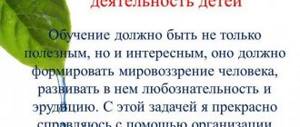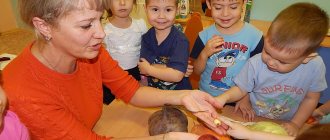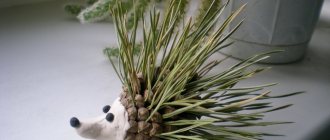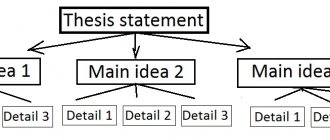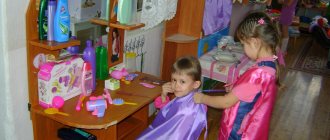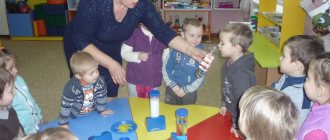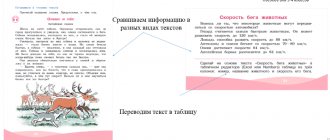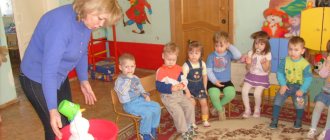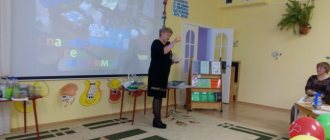Card file of experiences and experiments in the preparatory group
There are many activities for the development of children.
Experiments with magnets of various origins
Execution: Children are asked to use paper clips or other metal objects to measure the force produced and then compare the properties.
Experiments with sand
You need two empty plastic bottles, sand, an awl, and tape.
Progress:
- Connecting the lids with tape, flat sides to each other.
- Making a hole with an awl in the center of the glued lids.
- Adding sand to one bottle.
- Twisting both bottles.
Note! The result is an hourglass whose time is set independently.
Experiments with water develop knowledge
Experiments with water
Water is poured into containers of different shapes and sizes and the shape it takes is observed, noting the absence of color and odor.
Experiments with paper and sand
1/2 sheet of paper is rolled into a tube with a diameter of 1 cm. A pencil is inserted into it, and the structure is filled with sand to the base of the tube. The pencil is removed, and the child observes the integrity of the folded paper and the absence of deformations. Simple and educational!
Experiments with paper and water
Take two sheets of paper and place them on top of each other. The child is asked to move them. After which the sheets are saturated with water, and moving them is no longer so easy. Thus, an understanding comes of the adhesive ability of wet paper.
Experiments with fabric
It is necessary to provide several samples of different fabrics. Children must compare and analyze the material, its thickness, smoothness, strength, degree of wetting.
Experiments with air
The plastic bag is inflated and tightened. The teacher shows that the package holds its shape. Then the air is released and the bag falls. Conclusion: there was clear air in the bag.
Environmental education classes for preschoolers
Experiments in the middle group
Experiences and experiments cause genuine delight in children.
For your information! In addition to all this, they help preschool children learn new things about the world around them in a visual form and satisfy their search interest.
Visual examples are better understood
Experiments with paper
It would seem, what unusual could be in paper? Children see it every day, use it in art classes and make crafts and cards from it. But how surprised they will be to learn so many new things about her.
Experiment 1. Effect of water on paper
You need to take different types of paper that you have on hand. For example:
- table napkins;
- toilet paper;
- album sheet;
- newspaper;
- magazine cover;
- corrugated paper;
- paper handkerchiefs;
- cardboard;
- wallpaper, etc.
Cut pieces of approximately equal size and place them in trays with a small amount of water. It will be clearly seen that, for example, toilet and corrugated paper, napkins, paper handkerchiefs, and newspaper absorb water very well, and subsequently completely spread out in the tray. Cardboard and album sheets absorb water a little worse, as they are denser. And the worst absorbers of water (and therefore do not deteriorate longer) are wallpaper and magazine covers.
Experiment 2. How does paper tear?
You can invite children to tear different types of paper and see which of them will tear easily and which will require some effort.
Note! After this experiment, you need to connect the property of paper to tear with its property of quickly or slowly soaking in water. It turns out that those types that water soaks faster and tear much easier. But a magazine cover, cardboard, or wallpaper are more difficult to tear.
Experiments with paper are educational for children
Experiment 3. Fold in half
For this experiment, you need to prepare different types of paper of the same size. Children will have to check how many times each type of paper can be folded in half. Thick cardboard, a magazine cover, or a landscape sheet will fold much more difficult than a tissue or toilet paper of the same size.
Experiment 4. Move the apple
Again, the experiment is carried out using different types of paper. Its dimensions should be the same. The children's task is to transfer a medium-sized apple or any other object onto a sheet of different types of paper. You won’t be able to transfer anything on thin paper, but cardboard or a magazine cover will help you cope with this task.
Experience 5. Very convenient paper
The teacher suggests that children learn how to make bags from different types of paper. This is a very interesting activity, as a result of which children need to show that the bag can be used to carry or store small items.
Experiments with water
Water is a very interesting object for kids to explore.
For your information! During these experiments, it is important to convey to children that water can exist in three states: liquid, solid and gas.
Experiment 1. Icicle, melt
While walking, find icicles and put them in cups. Give the children the task of observing what will happen to the icicles at room temperature in the group room. After what they have seen, explain to preschoolers that at temperatures below zero degrees, water turns into ice, that is, it turns from a liquid state into a solid state. And at temperatures above zero degrees, water turns from ice into a liquid state. Therefore, when spring comes and it becomes warm, the icicles melt.
GCD lesson on speech development in the middle group
Experience 2. Oh, frost
In winter, pour a small amount of water into mugs with the children. On a daytime walk, take the mugs of water outside and leave them on the veranda until the next day. The next day, show the kids what the water turned into in the cold.
Experience 3. No taste, no color, no smell
The purpose of this experiment is to convey to children the information that water is a tasteless, transparent, odorless substance, and it loses all these qualities by adding something to it (sugar, jam, tea leaves).
Experience 4. Such an unusual steam
This experiment is carried out in winter. Warm water is poured into a container and taken with you on a walk. In the cold, you will clearly see how the water evaporates. The teacher also invites the children to exhale air from their mouths in the cold. Children will see steam that is formed due to the evaporation of moisture from the oral cavity.
Experience 5. No form
The little ones ask the question, does water have a form? If they answer that it has, then the adult spills a small amount of water on the surface. It will be seen that the water has spread out into a shapeless puddle.
For your information! For greater clarity, water is poured into containers of various shapes (preferably they are transparent): decanter, glass, jar, bottle, etc. Preschool children can see that water fills all the space in these containers and takes their shape.
Experiment 6. Different temperatures
For this purpose, you need three glasses of water: one with cold, another with warm, and the third with hot. Children will have to touch the water with their hands one at a time and determine for themselves which glass contains which water. Next, the teacher conducts a conversation and tells that some living beings are more comfortable living in warmer water, and some in colder water, about hot underground springs that do not freeze even at sub-zero temperatures and cold springs that do not heat up even in hot weather. day.
Experiments with snow
It’s also useful to experiment with snow.
Experiment 1. Snow melts
The walk will become even more interesting. The experiment is to show preschool children that snow melts based on body temperature. Children take a little snow in their palm and watch how it turns into water under the influence of body heat.
Melting snow is entertaining
Experience 2. Winter and modeling
You need to take the molds that kids use to play in the sandbox in the summer, and a spatula to knock on the mold to make it easier to separate the snow figure. Show them that snow can easily take any shape and can be very dense if compacted.
For your information! This experiment requires choosing weather conditions in which the snow will be wet. Or take water in a container for a walk, which can be used to wet the snow.
Experience 3. Thai, snowball
The experiment is carried out to find out how much water can be obtained from snow. The snow is collected in a bucket, compacted and left to melt indoors. When the snow melts, the little ones will be surprised to discover that there was much less water in the bucket than the amount of snow that was collected. This is due to the fact that snow has a low density compared to water.
Experiment 4. Let's color the snow
The whole group will really enjoy this activity. You can paint the snow after experiment number two, “Winter and Modeling,” or you can do it yourself. Gouache paint solutions in plastic bottles are taken outside. And after painting with multi-colored water, the figures made from snow will become very bright. You can organize a snow sculpture competition on the territory of the kindergarten, paint a snow woman, a snow flower bed, a symbol of the New Year and much more.
Thematic week in the second junior group “Professions”
